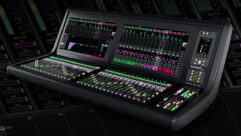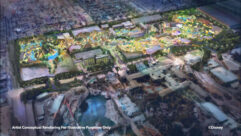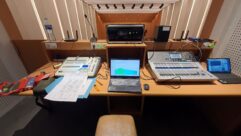COVERING IT ALL
Apr 1, 2000 12:00 PM,
Joyce Jorgenson
A theatre in the round, Marriott’s Lincolnshire Theatre required specialattention to deliver sufficient intelligibility and SPL to every seat inthe house.
Located within a sprawling 168 acre (67 hectare) resort complex, Marriott’sLincolnshire Theatre brings well over 400,000 people to the Chicago suburbof Lincolnshire each year. Once known as Drury Lane Theatre North, thefacility plays host to a seemingly endless string of world-class musicalsstaged within the framework of a nonstop production schedule featuringback-to-back matinees and evening shows.
With little dark time available to perform maintenance and makeimprovements to the theatre’s technical infrastructure, the concept ofinstalling a new audio system within this room has the distinct potentialof being equated with famous train wrecks and other cataclysmic events.Fully realizing this himself, when the time came to undertake just such aproject, the Marriott Lincolnshire’s resident sound designer David Lewiscalled upon someone who perceives such tasks as merely all in a day’s work,sound designer Duncan Edwards.
Edwards was singled out for the job because of his vast experience intheatrical sound design for Broadway and off-Broadway productions, touringand regional theatrical productions, musical theatre and plays. As a NewYork-based sound designer, his primary focus has been in theatrical venues,although over the past 20 years, his design and engineering talents havecontributed to projects ranging from 50-seat theatres to 100,000-seatstadiums.
The outer main ring consists of 11 identical clusters, each using a UPA-1Pon top and a horizontally mounted UPM-1P underneath. The UPA-1Ps cover themiddle and back rows of each seating section with the broader pattern ofthe UPM-1Ps providing coverage for most front rows. An inner ring of fiveUPM-1P cabinets supplements the first two rows and also serves as a monitorsystem for the performers on stage. To augment deep bass response, USW-1Psubwoofers are flown above the outer clusters on three sides of the stage.
As fate would have it, in addition to being asked to help upgrade theMarriott Lincolnshire’s house sound, Edwards was also chosen to serve asthe sound designer for the theatre’s production of “Phantom of the CountryPalace,” a show by Morey Yeston (the composer/lyricist behind Broadway’s”Titanic” and “Grand Hotel”), which was scheduled to open on October 27,1999.
With Edwards pulling double-duty as both house installationconsultant/system designer and sound designer for “Phantom,” it logicallyfollowed that he would be able to integrate the two positions. One of thebenefits of this arrangement was that he was able to stay with the theatrefor a length of time, which allowed him to fine tune the system underactual technical rehearsal and show conditions.
Working directly with David Lewis on the project, Edwards came face-to-facewith a daunting schedule providing less than three days between the closingof one show and the opening of “Phantom,” during which time the new audiosystem had to be installed and up-and-running.
“Theatre management wanted a reliable system that would providehigh-quality sound with maximum impact,” Edwards said of the guidingphilosophy behind his and Lewis’ fast-track efforts. “This being the case,one of our main objectives was to produce a design that would provideuniform coverage throughout the house, while clearly maintaining theperception that all sound remained true to its source onstage.”
Employing an in-the-round configuration, the Marriott Lincolnshire has roomfor 882 people within just nine rows of seating. Each fan-shaped seatingsection starts with 11 seats in the front row. By the seventh row, each is38 seats wide. The first section is unique in that it includes aglass-enclosed, acoustically treated orchestra booth taking up the lastthree rows. Sections two, three and four are identical. Edwards and Lewisultimately penned a multi-cluster design for the room using self-poweredmodular components from Meyer Sound Labs.
“One must really think of the system as having eleven identical clusters,each composed of one Meyer Sound UPA-1P at the top and one Meyer SoundUPM-1P on the bottom,” Edwards said. “All of these clusters aresymmetrically spaced around the perimeter of a ceiling-mounted grid. Theclusters derive their signal from a single matrix output. Above the sectiontwo, three, and four clusters is a USW-1P subwoofer also from Meyer Soundwhich receives its signal from an auxiliary send. An inner ring of UPM-1Psprovides fill for the first two rows of seating. Fed by an additionalmatrix output, this inner ring also provides the initial source for systemdelay, and allows performers to hear their own vocals.
“For this theatre, we didn’t want to design a high-Q, point source system.Instead, we went for low-Q devices distributed in a line array designed todeliver a coherent pillow of sound emanating from the stage. Because thedistance from the grid to the back row of seats is only 25 feet (7.6 m),and the seating fans out very quickly, we needed to choose loudspeakersthat have a smooth, even and wide horizontal dispersion pattern. Inaddition to its favorable horizontal coverage pattern, I like the UPA-1P inthis space – or just about any theatre environment – because of its clean,transparent sound. Given the steep vertical coverage requirements of thisroom, I had to extend the vertical pattern of each UPA-1P with a UPM-1P.The under-hung UPM-1Ps are roughly 10 feet (3 m) from the nearest seat.Their coverage pattern was perfect for the distance.”
Each UPA-1P operates from 60 Hz to 16 kHz and covers 100 degreeshorizontally by 45 degree vertically. They are biamplified and consist of asingle 12 inch (305 mm) cone driver and a single 3 inch (76 mm) compressiondriver. Smaller in stature, the UMP-1P operates from 60 Hz to 22 kHz andleaves a 100 degree 100 degree footprint. It employs a biamplified,three-way design with dual 5 inch (127 mm) conical transducers and a 1 inch(25.4 mm) titanium dome high-frequency driver. The USW-1P subwoofersoperate between 32 Hz and 180 Hz. Outfitted with a pair of 15 inch (381 mm)drivers and a two-channel amp, these low-end devices disperse sound in apattern measuring 360 degrees horizontally by 180 degrees vertically. MeyerSound’s SIM System II was used to tune the system.
“Although there are other measurement products available, none, to myknowledge, is three-channel, and none is a turnkey system specificallydesigned for working with complex, multi-channel, multi-zone loudspeakersystems,” Edwards said. “I used the SIM system to make frequency response,phase and dB SPL measurements throughout the room. I also verified thefrequency response, phase,distortion, and gain structure of all theelectronic components.”
Once the electronics had been verified, Edwards placed measurement mics inthe field of coverage and checked the loudspeakers for phase and level toensure that each cabinet was performing the same relative to the others.With these preliminary checks completed, he repositioned the measurementmics within the individual zones and began to work with the loudspeakerscabinet by cabinet to build the sound throughout the room.
The EQ, level and delay sections of four XTA Electronics DP200 audioprocessors were used for controlling the system. After all of theindividual loudspeakers were equalized, Edwards examined the effects ofcombining loudspeakers and carefully used additional equalization, relativedelay and relative level to smooth out the frequency and phase response ofthe combined components using pink noise and music. Edwards likes to startwith pink noise and then add music because it is his feeling that systemsact differently with transients than within a steady state of pink noise.He also listened to the system using a hand-held mic and a head-mountedlavalier mic while checking for resonance frequencies in the room. Basedupon these tests, he took further action to minimize any problems whenpossible. The delay timing of the entire system was set to synchronize witha performer just past center stage.
A turnkey system running proprietary software on a DOS operating system,the SIM System II consists of a rack-mounted PC with three measurement DSPcards, and an external 2 RU, eight-channel switcher that allows for threemeasurement points per channel. Typically, the points are the input andoutput on an EQ and a measurement mic. The switcher allows for easycomparison of the signal before the EQ, after the EQ, and at a measurementmic position in front of the loudspeaker arrays.
According to Edwards, the three days he and the rest of the installationteam had to complete the system went like this: “On the Sunday after theclose of the first show, we took down the existing loudspeaker arrays.Then, on Monday, we came in and hung the new arrays. With the help of acrew from TC Furlong, all the terminations were made. TC Furlong is a MeyerSound dealer from nearby Lake Forest, IL, and the equipment provider forall of the new components. Tuesday morning, we verified the system and madepreliminary adjustments to prepare for afternoon cast rehearsals. Wednesdaymorning, again with the help of TC Furlong, we performed extensive systemtuning prior to the orchestra dress rehearsal that afternoon. The firstpublic performance was that evening. On Thursday, I performed a few moretweaks, and that was it. On this job, we had to be extra creative with thedesign to meet high expectations and still have everything up and runningin a very short amount of time. These kinds of parameters aren’tnecessarily complementary, but that’s what made it all quite interesting attimes.”
If the comments of the Marriott Lincolnshire Theatre’s Executive DirectorCary Walker are any indication, the project can certainly be deemed asuccess.
“I can’t believe I’ve had to work here for 17 years before hearing showslike this,” he said. “The opening of `Phantom of the Country Palace’ wasspectacular. I give Duncan’s sound design the credit. This was a verycomplex space to work with, because it was never intended for musicaltheatre. He changed all that, and with blinding speed I might add.”










